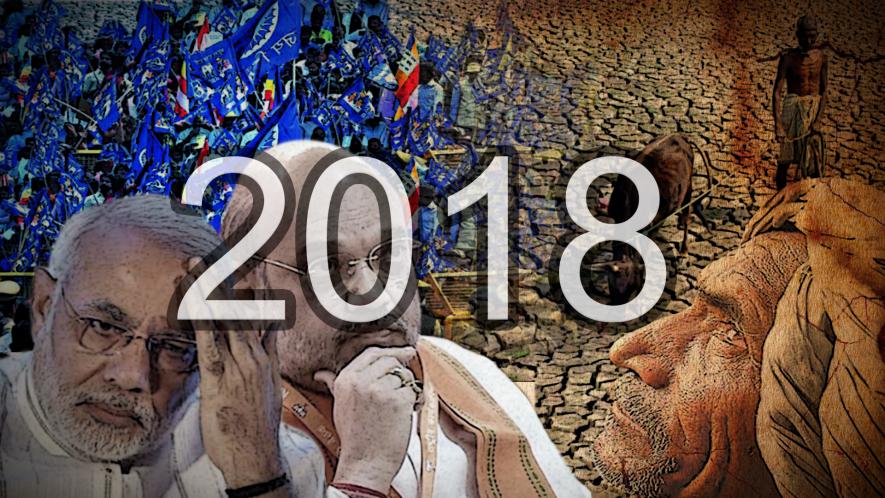2018: Dalit Anger, Farmers’ Struggles and the Election Debacle of BJP

The year 2018 was Modi’s nightmare, though he and his party continued to blithely go about as if they are invincible vishwa-gurus. A combination of disastrous economic policies in the past few years under Modi and an unalloyed commitment to favour big corporates, especially selected cronies, has led practically every section of Indian society to become disillusioned with the BJP rule. As if this was not enough, the upper caste brand of aggressive Hindutva propagated energetically by the Sangh Parivar has heightened social tensions on caste and religious lines. Through all this tumult, the BJP’s desperation to stick on to the power by hook or crook, side-lining democratic institutions and norms, trampling individual rights and subverting institutions has also become clear to all.
The year gone by is perhaps the beginning of the end of Modi and his brand of poisonous politics, his deceptive jumlas, his silences, and his synthetic thunder that was drummed into everybody’s heads. Some key features and events of 2018 show Modi’s decline in a nutshell.
Dalit Anger: Bhima Koregaon and Afterwards
On the very first day of 2018, Dalits gathered at Bhima-Koregaon village in Maharashtra to commemorate a victory over Peshvai rule were attacked by Hindutva conspirators leading to widespread violence and arson. Over 250 Dalit and other democratic organisations called for a Maharashtra bandh. The incident, in one shot, showed both the anti-Dalit nature of aggressive Hindutva as also the simmering anger among Dalit communities due to increasing atrocities under Modi rule. Later, the Sangh parivar manipulated the BJP state government to draw a tenuous connection between the violence and several rights activists who had participated in the Elgar Parishad in Pune. The whole thing was turned on its head – these activists were declared ‘urban naxals’, conspiring to assassinate PM Modi and hence arrested, while the instigators of violence in Bhima Koregaon – Sambhaji Bhide and Milind Ekbote remain at large. The whole charade was also meant to divert attention from the murderous activities of Sanatan Sanstha, a violent Hindu organisation responsible for killing rationalists and progressive thinkers.
Later in the year, the BJP’s vacillation on the Supreme Court verdict diluting the SC/ST Prevention of Atrocities Act caused Dalit and Adivasi communities across the country to rise up in protest. Again, a bandh was called in April, and again there was upper caste violence. Thus, the cycle continued, with the BJP getting more and more isolated at every step.
Farmers' struggles
Farmers had been struggling for better prices for their produce and freedom from debt for the past few years. These struggles had spread across at least 13 states. In 2017, a three-day Kisan Mukti Sansad was held in Delhi demanding legislation on these issues. In March 2018, over 50,000 peasants marched to Mumbai in what was dubbed as the Long March, demanding better prices and wages. Later, the struggles coalesced, and acquired a much bigger sweep and potency. One key reason for this was that their struggles became more and more united with industrial workers. On September 5, a massive joint rally of farmers and workers took place in Delhi steeling this united front. Another feature of the farmers’ struggle was that they inexorably moved towards demanding an ouster of the Modi govt. On November 30, farmers from across the country congregated in Delhi again demanding a special Parliament Session to consider and resolve the burning issues of farmers. These repeated and ever strengthening movements reverberated in all parts of the country, with the cry for Modi government’s ouster growing stronger. In assembly elections, it was expressed in a rejection of BJP.
Modi's defeat in Assembly Elections
BJP lost a series of assembly elections in 2018, confirming in a spectacular way that Modi’s rule had begun to crack up in the face of people’s discontent. First, the BJP’s bid to wrest power in Karnataka came a cropper despite a huge display of money and muscle power, and despite Modi-Shah’s high decibel campaign. But the real sign of BJP’s eroding support came in the most recent assembly polls in MP, Chhattisgarh and Rajasthan where it was ruling. It suffered a humiliating defeat, especially in MP and Chhattisgarh where it had been ruling for 15 years continuously. The vote against BJP was partly a rejection of the twin disasters of demonetisation and GST, but also primarily, caused by farmers’ anger and Dalit-Adivasi alienation from the saffron party.
The defeats showed that people were tired of four and a half years of the Modi rule. They were tired and angry over rising unemployment, neglect of farmers, distressed by atrocities on Dalits and Adivasis, ruined by price rise and wage freeze. It was, in short, a rejection of the whole package of neo-liberal policies that favour super profits for corporates, privatisation, deregulation and withdrawal of state support for welfare programmes. The results also busted the fond hope of BJP and Sangh parivar that Hindu mobilisation in the name of violent communalism and ultra-nationalism will bring electoral gains. After all, the Ram Temple issue was the single biggest point raised by BJP’s chief campaigner Yogi Adityanath, chief minister of UP. Yet, the BJP lost.
Get the latest reports & analysis with people's perspective on Protests, movements & deep analytical videos, discussions of the current affairs in your Telegram app. Subscribe to NewsClick's Telegram channel & get Real-Time updates on stories, as they get published on our website.
























